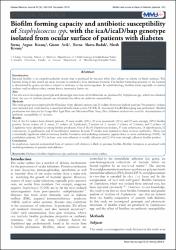| dc.contributor.author | Kıvanç, Sertaç Argun | |
| dc.contributor.author | Arık, Gizem | |
| dc.contributor.author | Akova-Budak, Berna | |
| dc.contributor.author | Kıvanç, Merih | |
| dc.date.accessioned | 2019-10-19T16:02:53Z | |
| dc.date.available | 2019-10-19T16:02:53Z | |
| dc.date.issued | 2018 | |
| dc.identifier.issn | 1995-7262 | |
| dc.identifier.issn | 1995-7270 | |
| dc.identifier.uri | https://dx.doi.org/10.4314/mmj.v30i4.6 | |
| dc.identifier.uri | https://hdl.handle.net/11421/13964 | |
| dc.description | WOS: 000456650500006 | en_US |
| dc.description.abstract | Introduction Bacterial biofilm is an exopolysaccharide matrix that is produced by bacteria while they adhere on abiotic or biotic surfaces. The bacteria living in this matrix are more resistant to antibiotics than planctonic bacteria. The biofilm formation property of the bacteria is determined by genes; and this is related to virulence of the microorganism. In ophthalmology, biofilms form especially on abiotic surfaces such as silicon tubes, contact lenses, intraocular lenses etc. Aim Our aim was to investigate genotypic and phenotypic structures of biofilms that are produced by Staphylococcus spp., which was obtained from the eyes of diabetic patients and determine the effect on antibiotic susceptibility. Methods The study group was comprised with 83 isolates from diabetic patients and 21 isolates from non-diabetic patients. Presumptive isolates were detected and confirmed by a microbial identification system VITEK II. Automated EcoRI Ribotyping was performed. Biofilm production was detected by Congo Red Agar Plate and Microtiter Plate Assay. Disc diffusion method was used for determination of antibiotic susceptibility of isolates. Results Out of the 83 isolates from diabetic patients, 25 were weakly (30%), 20 were moderately (24%), and 25 were strongly (30%) biofilm positive. Seven isolates of S. aureus, 11 isolates of S. epidermidis, 2 isolates of S. warneri, 3 isolates of S. hominis, and 2 isolates of S. lugdunensis were identified as strong biofilm producers. Out of the 83 Staphylococcus isolates, 37 were cefuroxime, 18 ciprofloxacin, 11 vancomycin, 12 gatifloxacin, and 18 moxifloxacin resistant. In total, 37 strains were resistant to three or more antibiotics. There was a statistically significant relation between biofilm formation and multidrug resistance (against three or more antibiotics,p<0.001). In nondiabetic patients, 15(71%) isolates were non adherent or weakly adherent, and 2(10%) were strongly adherent biofilm positive. Conclusion In conclusion, bacterial conjunctival flora of patients with diabetes is likely to produce biofilm. Biofilm formation is associated with multidrug rsistance in patients with diabetes. | en_US |
| dc.description.sponsorship | Anadolu University of Research Project Fund [1306F164] | en_US |
| dc.description.sponsorship | This study was supported by "Anadolu University of Research Project Fund" (Project No: 1306F164) | en_US |
| dc.language.iso | eng | en_US |
| dc.publisher | Med Coll Malawi | en_US |
| dc.relation.isversionof | 10.4314/mmj.v30i4.6 | en_US |
| dc.rights | info:eu-repo/semantics/openAccess | en_US |
| dc.subject | Diabetes | en_US |
| dc.subject | Biofilm | en_US |
| dc.subject | Staphylococcus Spp. | en_US |
| dc.subject | Antibiotic Resistance | en_US |
| dc.subject | Ocular Surface | en_US |
| dc.title | Biofilm forming capacity and antibiotic susceptibility of Staphylococcus spp. with the icaA/icaD/bap genotype isolated from ocular surface of patients with diabetes | en_US |
| dc.type | article | en_US |
| dc.relation.journal | Malawi Medical Journal | en_US |
| dc.contributor.department | Anadolu Üniversitesi, Eczacılık Fakültesi, Mikrobiyoloji Anabilim Dalı | en_US |
| dc.identifier.volume | 30 | en_US |
| dc.identifier.issue | 4 | en_US |
| dc.identifier.startpage | 243 | en_US |
| dc.identifier.endpage | 249 | en_US |
| dc.relation.publicationcategory | Makale - Uluslararası Hakemli Dergi - Kurum Öğretim Elemanı | en_US] |
| dc.contributor.institutionauthor | Kıvanç, Merih | |


















